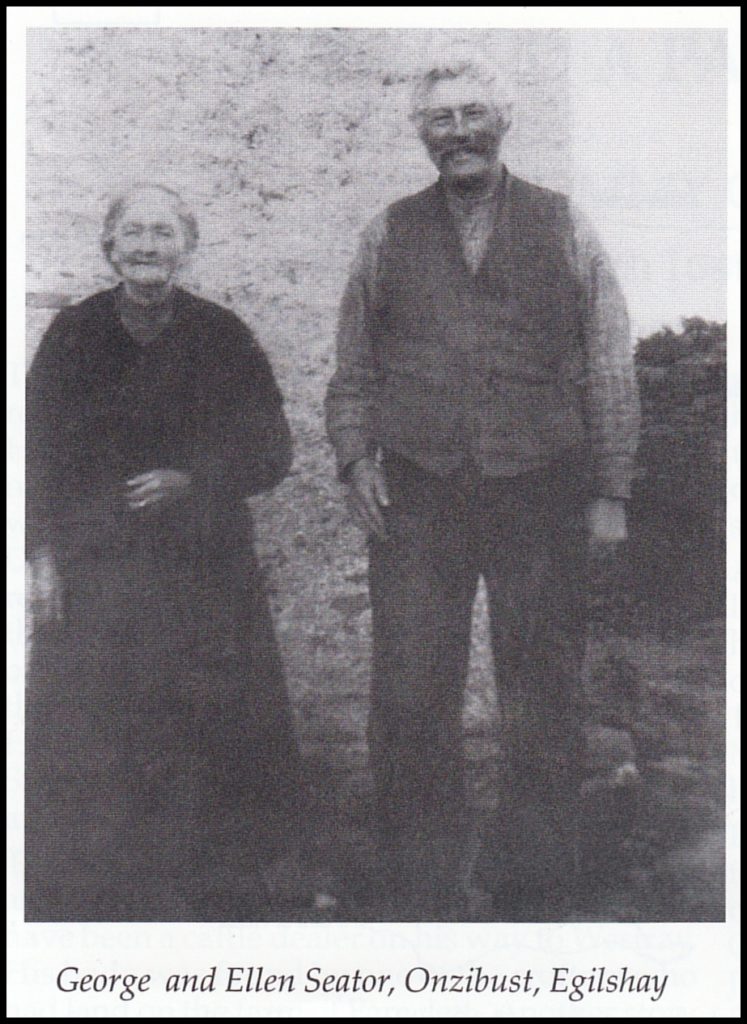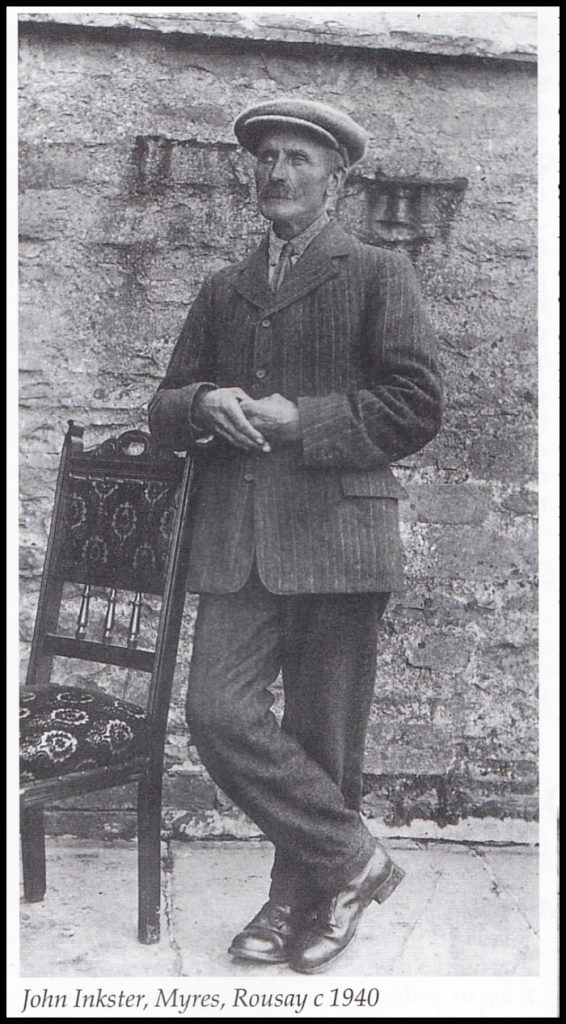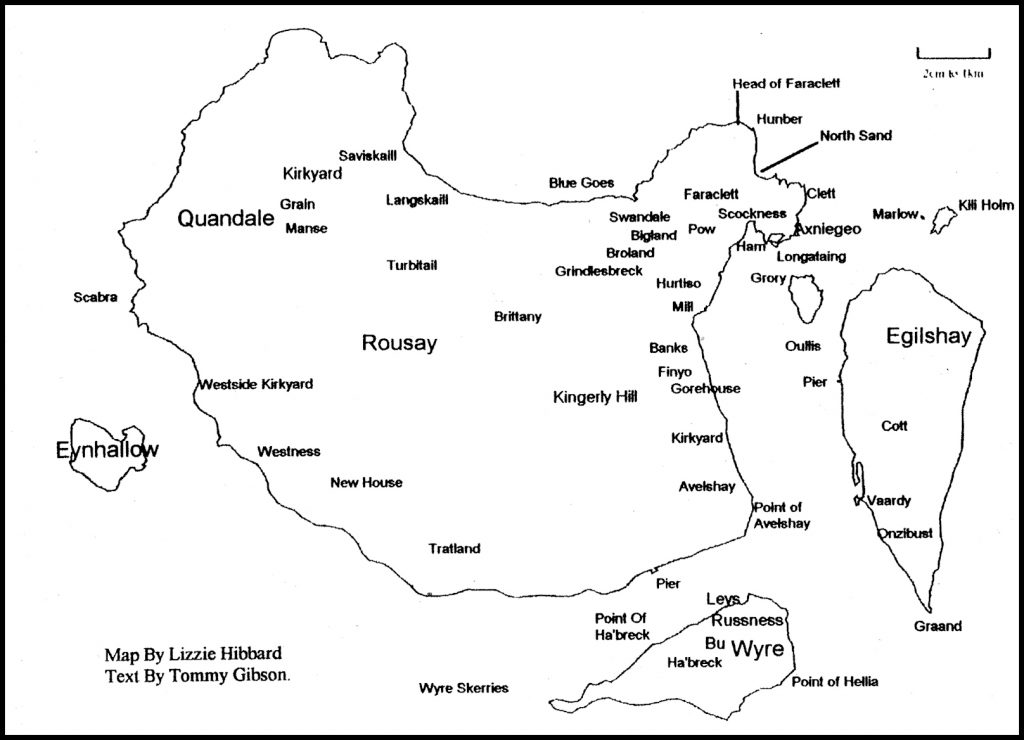Tommy Gibson of Rousay writes of boats and men lost in his area over the years.
[Taken from the pages of issue No.83 of The Orkney View published in 1999,
and reproduced with kind permission of the magazine’s editors
and the author, who also supplied the photos]
The parish of Rousay, Egilshay and Wyre is not renowned for its shipwrecks, unlike for example, Hoy, Sanday, Westray or Stronsay. In the nineteenth century fishing was a main industry, with a lot of men making a living from the sea. Despite this, the number of casualties was remarkably low. There were more losses among the non-fishing population. In common with other islands, however, there are graves along the shoreline from long ago, particularly on the Holm of Scockness and on Rousay at The North Sand, and on the land of Faraclett at Hunber and the Clett.
The first story is of a body of a man which came ashore in the North Sand. He was supposed to have been a cattle dealer on his way to Westray. His body was found by one of the crofters who had land on the farm of Faraclett. Another story I heard about was of a large ship partly laden with dried tea-leaves, which went ashore in the Leean. The people of Wasbister and Quandale did not know what to do with the cargo. They tried to feed it to the cattle, with no success. They even tried to make porridge out of the tea and they also tried to smoke it. In the end they used the tea for bedding for the cattle and pigs!
Another ship, the Atlantis, ran aground on the point of Grory on the Holm of Scockness, and the tide took her to below Finyo where she sank. She was about 60ft of keel, with a general cargo, mainly crockery. The next story concerns a Westray skiff laden with meal from the Sourin Mill on route back home to Westray. They were sailing past Axnigoe, Scockness, and missed a tack and the boat ran aground on the sloping rocks of the Clett. The boat filled with water and two or three men were drowned. No written record of any of these incidents was found.
Fishing for ‘kuithes’ and ‘sillocks’ from the Rocks or Craigs in Rousay was a needy and pleasurable task on a fine summer night. There are lots of ‘fishing places’ or points around the coast. One is Hunber, which lies east of the head of Faraclett, with a strong tide running past. At Hunber is a place called ‘Koldeross’, a dangerous ledge over deep water, where sometimes due to lack of space, people had to fish. John Gibson, of Broland, fell into the sea from this ledge. The men around him cast their ‘waands’ at him, and caught him on the collar with their ‘flees’ and saved him.
A stone in the Westside Churchyard reads; “Here lies the body of James Sinclair, Newhouse, husband of Madie Hourston, who was drowned on the reef of Skebray (Scabra) on the 20th Dec. 1825 aged 41”. Also in the boat were two Mainland boys from Tratland, Alexander and his brother whose name is not known.
In the Scockness Kirkyard there is a headstone to John Gibson of Pow, a Sourin fisherman and crofter of 6 acres who died in his boat on the 1st October 1854, possibly of a heart attack. His son, James, would not set foot in a boat after his father’s death.
In 1861 four Wyre men were tragically lost off the point of Ha’breck. This followed a visit to the registrar and the Off Licence in Rousay about the wedding of Annie Sabiston, a sister of the men who drowned, due to the upsetting of an open boat. They were John Sabiston, 32, farmer of Ha’Breck, Alexander Sabiston, 25, seaman in the merchant navy, James Baikie, 26, shoemaker, (the groom) and Hugh Craigie, 41, farmer married to Mary Louttit. There is in the Wyre Kirkyard a headstone with the inscription “Erected in memory of John Sabiston who was drowned Jan. 2nd 1861 aged 32 years. Also his son Alexander who died 19th Dec.1882 aged 23 years, together with his wife Mary Corsie who died at Paplay House, Eday, 5th May 1908 aged 86 years”. The same year Robert Inkster aged 8 of Swartifield fell over the Blue Goes and was killed. His body came ashore on Eday and was buried there. On the 26th August 1875 Robert Gibson of Langskaill, aged 36, and his son David, aged 8, were drowned in an open boat. This was due to a heavy land sea below Saviskaill when they came ashore. On the 19th January 1877 four were lost off the Isle of Eynhallow; William Rendall, 54, John Corrigall, 44, David Hourston, 3 and John Brown, 51. Nothing is known of this accident, nor why a three year old child was on the boat in the middle of winter. In another accident Thomas Shearer aged 15 was drowned while bathing in the sea near Saviskaill on the 4th August 1878.
On a headstone in the Wasbister kirkyard we read “In loving Memory of Hugh Inkster, of Brittany, drowned in Westray Firth on the 14th May 1879 aged 29 years.” It is thought that the boom hit him and he was knocked overboard.
Alan Gibson, a ploughman of Scockness, found a body at the North Sand on the 20th June 1882. In the Scockness Kirkyard a headstone bears this inscription, “In loving memory o f Alexander Henderson who lost his life accidentally by falling off the cliffs at the Blue Goes, May 14th 1883 aged 15.” The local story of this incident is that two lads on a trip from Kirkwall were walking to Wasbister and came to the steep braes at the back of Swandale where they both took to rolling down to the shore. One fortunately came to a standstill; the other went over the cliffs. The other boy took to running down the Sourin valley towards Hurtiso. He would stop and shout the boy’s name, run on and stop again, and continued shouting. Nothing more is known of this incident.
An extract from The Orcadian, March 22 1884, tells of another disaster. “A small yawl boat, between 11 and 12 o’clock on Tuesday morning, manned by 2 men left Westness for the purpose of procuring medicine from the doctor in Evie. The weather rough, flood tide, and a nasty sea. The crew comprised of two men, William Louttit and John Kirkness. When about half a mile from the shore, the boat was seen to ship a sea on the weather bow, which threw the bow off, when it encountered a heavy sea on the weather quarter, and immediately went down with both the men, who were lost. A boat put off from Rousay, but was too late to render any assistance. About one hour later the unfortunate boat was driven ashore, but with no trace of the men. The sad loss cast a gloom over the Island.” William Louttit, 31, a fisherman, The Manse, Wasbister, was married to Margaret Gibson, and had three children. John Kirkness, 27, mason, Grain, Wasbister, was married to Isabella Mainland, Gorehouse, and had two children. The bodies of the two men were never found. William’s son William, aged eighteen months, was ill at the time with appendicitis. He died at Broland aged 12.
On the 2nd December 1890 Hamo Gregerson, of Christiansund, Norway, aged 21, was swept overboard from the ship Iolle. He was the second Mate. His body was not recovered.
In a sad accident in Eynhallow Sound on Wednesday 11th October 1893 six lives were lost. James Sinclair, aged 75, a boatman, of Newhouse (his father was drowned in 1825, see above), John Reid, aged 56 from Tratland, Lydia Gibson, (Craigie) aged 35 from Turbitail, later Lochend, Stenness and her family David 9, Maggie Jessie 6, and Mary Ann 4 were all drowned. The crew is buried in the Westside Kirkyard. Lydia is in the Wasbister Kirkyard, and the children are in Stenness. Part of a report in The Orcadian dated Saturday 14th October 1893 runs; “Later information regarding the accident is to the effect that when the ill-fated boat left Evie on Wednesday, it was close reefed. All went well while it was under lee of the land, but immediately it rounded Aikerness Point it was struck by a squall and was upset. The two boatmen – Reid and Sinclair – were seen clinging to the boat for a minute or two, but it partly righted itself throwing them in the water and they were never seen again. A small boat manned by Wm. Wood, Wads, and John Mowat, Woodwick, Evie, was at that moment within 150 yards of the scene of the accident, but owing to the terrific gale, then blowing, had great difficulty in getting to the place, and by that time, men, woman and children had disappeared. A boat manned by David Miller, Merchant and Magnus Mowat, Evie, also put out from the shore, but could get no trace of the unfortunate people who were on board the mail boat. The boat was seen to turn several times over, and was carried away past Rousay towards the Atlantic”. This was the worst boating disaster in the parish.

During a storm on Sunday the 5th of January 1905 the steam trawler Excelsior, with Captain Martin of Hull, ran aground on the rocks at the Graand, Egilshay. She was severely damaged and was making water. During the night the crew were taken off and landed in Egilshay. The steam trawler Edward Roberts came up during the afternoon and remained in the neighbourhood till Monday afternoon, when all hope of getting the Excelsior off, by ordinary means, was abandoned. She then took the Excelsior’s crew to Kirkwall. It is interesting to note that the night the crew were rescued from the Excelsior was too stormy to launch a boat at Vaardy, Egilshay, the usual place to land and take off, which meant that a band of Egilshay men dragged a skiff on dry land from Vaardy to the Graand, being a mile and a half, had it been a straight road. The only light they had to keep them was an old fashioned lantern, with a thin cloth around it, to save it being blown out by the storm. Mr George Seator of Onzibust, the nearest farm to the Graand, stood in the boat and lifted members of the crew down into the boat, so saving them all. He took them to his house where they had food and rest till Monday, when the Edward Roberts took them to Kirkwall. Many of George Seator’s descendants are around Orkney today. They have good reason to be proud of him and the others who took part in this daring rescue. The boiler from the Excelsior can still be seen at low water on the Graand ninety-four years later.

John Logie of Grindlesbreck, a cattle dealer, died aboard the MV Fawn at the Rousay pier on the 11th February 1906. In Egilshay Sound, on the 3rd of April 1907, a boat left the Rousay pier for Egilshay with David Flaws aged 69 of Cott, Egilshay and John Inkster, a servant man, with some plough irons. About 1.15 pm. in a strong S.E. wind off the point of Avelshay, the sea struck her and threw her over the two men in the sea. This was seen from Egilshay. James Seatter and James Craigie made quickly to the scene and found John Inkster clinging to an oar. They quickly rescued him for he was in a bad way and they feared for his safety. David Flaws and the boat had disappeared. His body was never found. A yacht The Blue Dragon owned by Mr. C. Lynam, an Oxford Don, came and anchored in Wyre Sound off the Leys. That night a strong wind from the west blew her ashore below Russness. The four of a crew were unhurt and there was no damage to the boat. Two stayed at Russness and the other two stayed at The Bu. This happened on a Tuesday morning and by Saturday morning she was refloated on the high tide.

That same year on the 20th November, Robert Kemp, a farmer and cattle dealer from Langskaill, Gairsay was at a farm sale at Saviskaill, Rousay. In the evening he was in a hurry to get over to Egilshay to buy some cattle and borrowed a boat from Robert Seatter, Banks, Sourin. The weather was good with a light breeze on the Rousay side and it was good moon light. It is not known how the boat foundered. It was most likely to have been on Oullis (pronounced Oo—lis), a skerry between the Holm of Scockness and the Egilshay pier. A walking stick belonging to Mr. Kemp and a pair of oars from the boat were found on the Holm of Scockness. Mr. Kemp’s body was never found, the boat came ashore in Sanday. The boat was burned on the Hill of Kingerly in the 1937 Coronation bonfire.
The SS Actif foundered somewhere to the East of Stronsay in 1915. Two bodies came ashore in Rousay and they are buried in the Glebe Kirkyard. An inscription on headstones reads; “In Loving memory of James Scott Jamison, who drowned through the Foundering of the SS Actif on the 25th December 1915 aged 37. Son of Andrew Jamison, Longhill, Shetland”. The other headstone reads; “Erected in loving memory of our dear Father Peter B. Brymer, Engineer, SS Actif who was drowned on the 25th Dec.1915.” The one body came in near the Kirkyard, the other was found by Edith Gibson on the sloped rocks below Avelshay. It is not known if the date is of the foundering, or the find, or the burial. On the 11th August 1920 Robert Scott, a seaman of Hurtiso was drowned aged 39.This was not in the parish. The Phyllis Bellman, an Aberdeen trawler ran aground on the point of Ridden on Kili Holm. She was going north, out to the fishing grounds. There were no casualties, and she was safely towed off. In the following years up to 1936 four trawlers went aground on Kili Holm. The Vest Havit, a Norwegian, went on the point of Pitten on the Northwest corner and sank. The Birkhall went on the point of Ridden, the Northeast corner. The Lord Wymburn went on below the Quoy and the Marina hit the skerry, Marlow and was damaged. She was towed off but the tide took her and she ended up on the Haas. There were no casualties. In the Brinian Kirkyard there are six headstones for seamen who came ashore in the Second World War. Only one name, that of “A. Rasmanus, a sailor, SS Chelsea, 30. 8. 1940, aged 33” is on the headstone. Sunday the 24th of May 1953 saw the Aberdeen trawler Unitia aground on Oullis, the skerry south of the Holm of Scockness. Again there were no casualties and the SS Earl Sigurd towed her off on Sunday the 8th of June. The people of the parish went out to the trawler with baking, milk and eggs and were given lots of fish, which were salted down. In these days the fish were large and good. Many a good dinner was had. In the early 60’s William Darling, an art teacher and keen amateur photographer, was lost over the cliffs at the back of Purse, at Hellia Spur, while taking photographs. His body alas was never found.
These are most of the tragedies that have occurred around the waters of the parish. Finally it is also interesting to note that I have only found one fatality in the farming community and none on the roads, in spite of many accidents and the many, many more narrow escapes ……….
